This xBmt was completed by a member of The Brü Club in collaboration with Brülosophy as a part of The Brü Club xBmt Series. While members who choose to participate in this series generally take inspiration from Brülosophy, the bulk of design, writing, and editing is handled by members unless otherwise specified. Articles featured on Brulosophy.com are selected by The Brü Club leadership prior to being submitted for publication. Visit The Brü Club Facebook Group for more information on this series.
Author: Ben Gansemer
One of the first pieces of advice given to most homebrewers for improving the quality of their beer is to control fermentation temperature. While we can all agree that maintaining the fermentation temperature within the recommended guidelines for a particular yeast strain is important, some would also say that to brew a proper version of a particular beer style using particular yeast strains, more precise control of the fermentation temperature is necessary.
This includes Belgian styles where many, including Stan Hieronymus in his book Brew Like a Monk, suggest starting fermentation at a lower temperature, around 63°F/17°C, then slowly ramping the temperature up to about 75°F/24°C. This method is purported to impart a balance of spicy phenols and fruity esters.
While several previous xBmts have suggested precise temperature control may not be as important as previously thought when using certain yeast strains, tasters were able to reliably distinguish a Weissbier fermented at 60°F/16°C from one fermented at 72°F/22°C. As a lover of Belgian beer styles, which are made with similarly characterful yeast, I decided to test whether a Witbier fermented with a “traditional” Belgian temperature profile would be perceptibly different than one held at a constant warmer temperature.
| PURPOSE |
To evaluate the differences between a Witbier pitched at 63°F/17°C then warmed by 1°F/0.5°C per day over a week and one consistently fermented at 70°F/21°C.
| METHODS |
For this xBmt, I brewed a 2.5 gallon/9.5 liter batch of my standard Witbier recipe.
Ollie’s Witbier
Recipe Details
| Batch Size | Boil Time | IBU | SRM | Est. OG | Est. FG | ABV |
|---|---|---|---|---|---|---|
| 2.5 gal | 60 min | 11.4 | 4.4 SRM | 1.046 | 1.007 | 5.12 % |
| Actuals | 1.046 | 1.007 | 5.12 % | |||
Fermentables
| Name | Amount | % |
|---|---|---|
| Pilsen Malt | 2.5 lbs | 51.28 |
| Wheat Flaked | 1.75 lbs | 35.9 |
| Oats, Flaked | 8 oz | 10.26 |
| Caramel Munich I | 2 oz | 2.56 |
Hops
| Name | Amount | Time | Use | Form | Alpha % |
|---|---|---|---|---|---|
| Hallertauer Mittelfrueh | 7 g | 60 min | Boil | Pellet | 4 |
| Hallertauer Mittelfrueh | 7 g | 15 min | Boil | Pellet | 4 |
Miscs
| Name | Amount | Time | Use | Type |
|---|---|---|---|---|
| Coriander Seed | 7 g | 5 min | Boil | Spice |
| Orange Peel, Bitter | 7 g | 5 min | Boil | Spice |
Yeast
| Name | Lab | Attenuation | Temperature |
|---|---|---|---|
| Belgian Witbier (3944) | Wyeast Labs | 76% | 32°F - 32°F |
Notes
| Water Profile: Ca 55 | Mg 0 | Na 8 | SO4 46 | Cl 69 |
Download
| Download this recipe's BeerXML file |
A week prior to brewing, I thawed out an aliquot of Wyeast 3944 Belgian Witbier and made a 100 mL starter to revive the yeast. A couple days later, I propagated that yeast in a 500 mL starter that was split into two identical 250 mL volumes for the separate 1.25 gallon/4.75 liter batches.
I started my brew day by collecting the full volume of water, adjusting it to my desired profile, and getting it heating up, at which point I prepared the grains.
Since this recipe has a fairly high percentage of flaked grains, I opted to do a protein rest, as I’ve found it improves my efficiency with such grists. After a brief 10 minute rest at 120°F/49°C, I added boiling water to bring the mash temperature up to 155°F/68°C for the remaining 50 minutes.
When the mash rest was complete, I removed the grains and gave the bag a gentle squeeze until my pre-boil volume was reached. While the wort was heating up, I weighed out kettle hops, coriander, and orange peel.
The wort was boiled for 60 minutes with hops and spices added at the times stated in the recipe. Once finished, I quickly chilled the wort before taking a refractometer reading showing it was at my target OG.

After racking identical volumes of wort to separate fermenters, one was placed in my fermentation chamber controlled to 63°F/17°C, while the other was placed in my basement closet that maintains a consistent 70°F/21°C.
I let the worts sit until the one in the chamber reached 63°F/17°C, which is when I pitched the yeast into both. I noticed signs active fermentation in the warm fermentation beer 6 hours later, though the cool fermentation batch showed no activity. At 16 hours post-pitch, both batches had developed a kräusen, though the cool fermentation beer was noticeably less vigorous.
Whereas the warm fermentation batch stayed around 70°F/21°C, I gradually increased the temperature of the cool fermentation batch by 1°F/0.5°C per day over 1 week until it reached 70°F/21°C. The beers were left alone for an additional 3 days before I took hydrometer measurements showing both finished at the same FG.

At this point, I racked each beer onto a priming sugar solution consisting of 33 g of dextrose in 150 mL of RO water then proceeded with bottling. Yielding 12 bottles per batch, I marked the 6th bottle from each for use in the semi-blind triangle test. After 2 weeks of conditioning, the beers were carbonated and ready for evaluation.
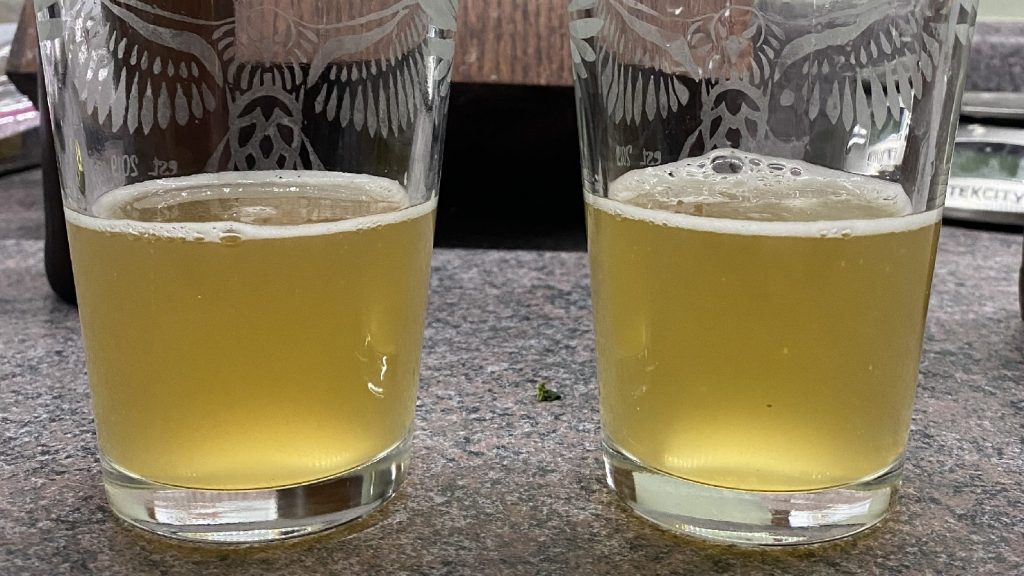
| RESULTS |
Due to social distancing practices as a result of the COVID-19 pandemic, data for this xBmt was unable to be collected from participants. As such, adaptations were made involving the author completing multiple semi-blind triangle tests in as unbiased a way as possible.
Utilizing 4 opaque cups of the same color where 2 were inconspicuously marked, one set was filled with the beer pitched at 63°F/17°C then gradually increased while the other set was filled with the beer fermented at 70°F/21°C. For each triangle test, 3 of the 4 cups were indiscriminately selected, thus randomizing which beer was the unique sample for each trial. Following each attempt, I noted whether I was correct in identifying the unique sample. Out of the 10 semi-blind triangle tests I completed, I needed to identify the unique sample at least 7 times (p<0.05) in order to reach statistical significance. Ultimately, I identified the unique sample just 5 times (p=0.21), indicating my inability to reliably distinguish a Belgian Witbier where the yeast was pitched at 63°F/17°C then gradually increased over time from one that was fermented uncontrolled in a 70°F/21°C environment.
When sampling these beers prior to evaluating them, I thought I picked up a bit more of a sulfur aroma in the cool fermented batch, though given my performance on the triangle tests, it’s possible this was due to my awareness of the variable. Both beers had a smooth mouthfeel with subtle hints of spice and citrus I expect in Witbier, making them very drinkable.
| DISCUSSION |
Fermentation temperature control is viewed as being vital for producing high quality beer. For some beer styles and yeast strains, particularly those of Belgian origin, some say this requires precise control, often starting fermentation at a lower temperature and gradually ramping it up to produce the desired characteristics. My inability to reliably distinguish a Belgian Witbier where the yeast was pitched at 63°F/17°C then gradually increased over time from one that was fermented at 70°F/21°C suggests any differences were too minimal for me to perceive.
It is possible these results may have been different if the warm fermentation batch was held at a cooler temperature, perhaps around 63°F/17°C, rather than 70°F/21°C, which I chose based on reports on online forums that Wyeast 3944 tends to stall if held at lower temperatures for too long. One could also argue that differences in fermentation character may also be more noticeable if the coriander and orange peel were left out of the recipe; however, both of those additions are traditional in Belgian Witbier and, in my opinion, including them allows for a more accurate representation of the style.
Having a temperature controlled fermentation chamber makes it easy to precisely control fermentation temperature, making it easy to vary the fermentation temperature. One easily observable difference between these beers is that the batch fermented warm not only showed signs of fermentation activity sooner than the one fermented cool, but it seemed to finish fermenting earlier as well. If I can produce a perceptibly similar beer in a shorter amount of time, I’m going to do it. When exploring this variable in the future, I plan to nix the gradual ramping component and hold both batches at a stable temperature throughout fermentation.
 Ben Gansemer is currently a graduate student studying neurobiology in Iowa. His scientific background fueled his foray into homebrewing and experimenting with beer. Ben enjoys spending time with his amazing wife (who graciously helps with triangle tests) and son (who enjoys adding hops on brew days). He started brewing in 2019 and blames Brülosophy for sucking him into the hobby so rapidly. When he’s not brewing or spending time with his family, Ben likes to fly fish, cook/bake, and play guitar.
Ben Gansemer is currently a graduate student studying neurobiology in Iowa. His scientific background fueled his foray into homebrewing and experimenting with beer. Ben enjoys spending time with his amazing wife (who graciously helps with triangle tests) and son (who enjoys adding hops on brew days). He started brewing in 2019 and blames Brülosophy for sucking him into the hobby so rapidly. When he’s not brewing or spending time with his family, Ben likes to fly fish, cook/bake, and play guitar.
If you have any thoughts about this xBmt, please do not hesitate to share in the comments section below!
Support Brülosophy In Style!
All designs are available in various colors and sizes on Amazon!
Follow Brülosophy on:
FACEBOOK | TWITTER | INSTAGRAM
If you enjoy this stuff and feel compelled to support Brulosophy.com, please check out the Support page for details on how you can very easily do so. Thanks!


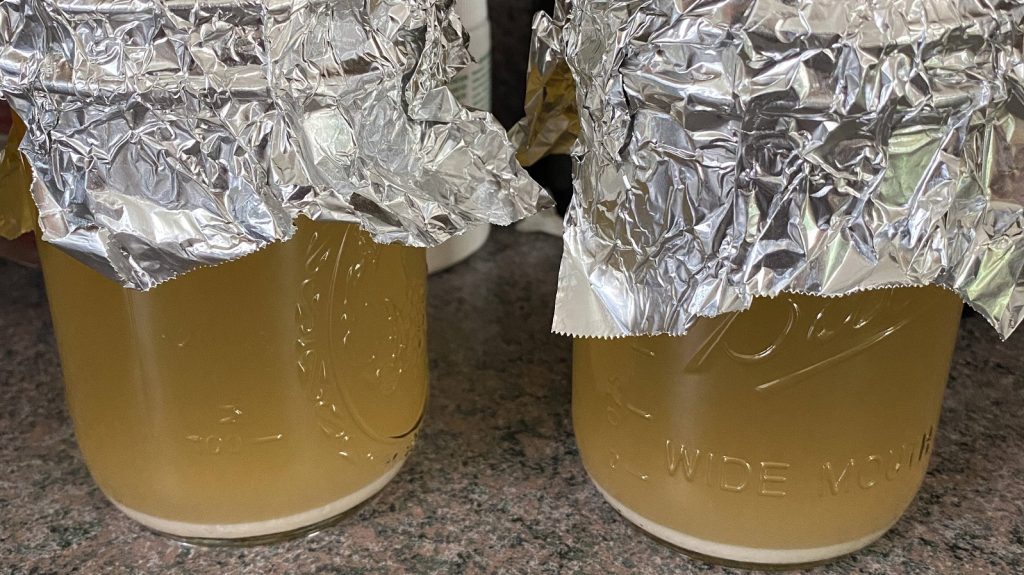
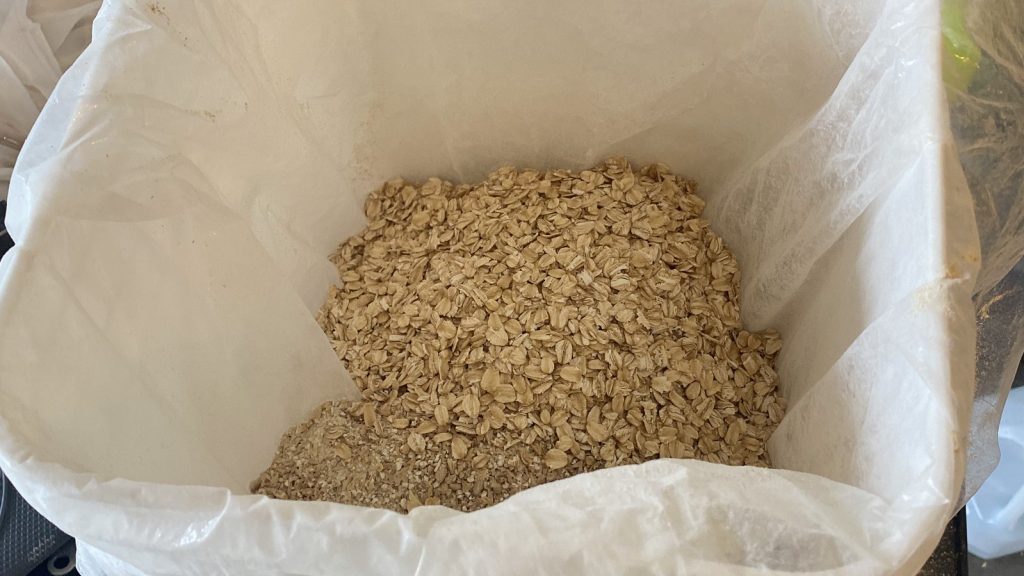


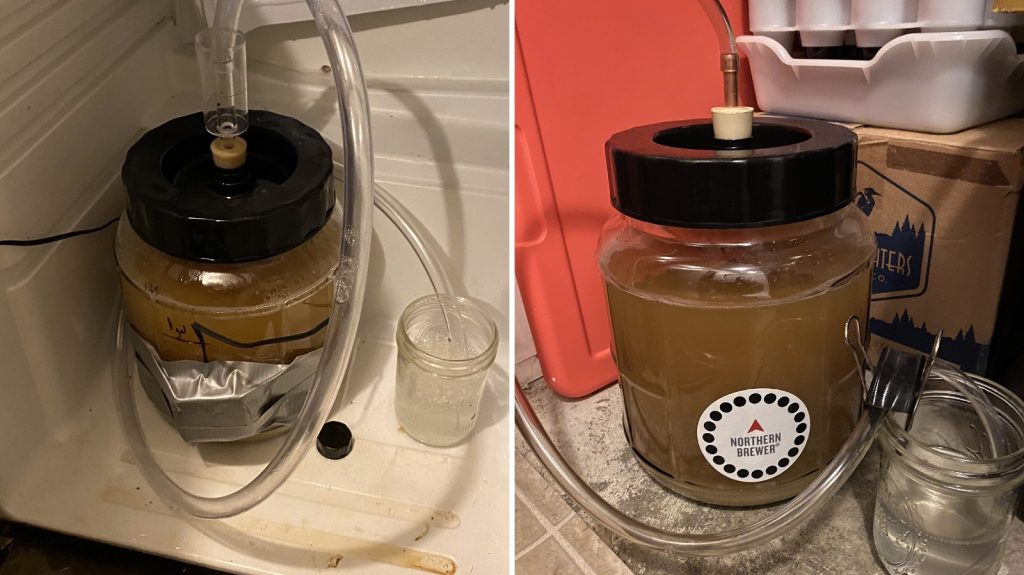
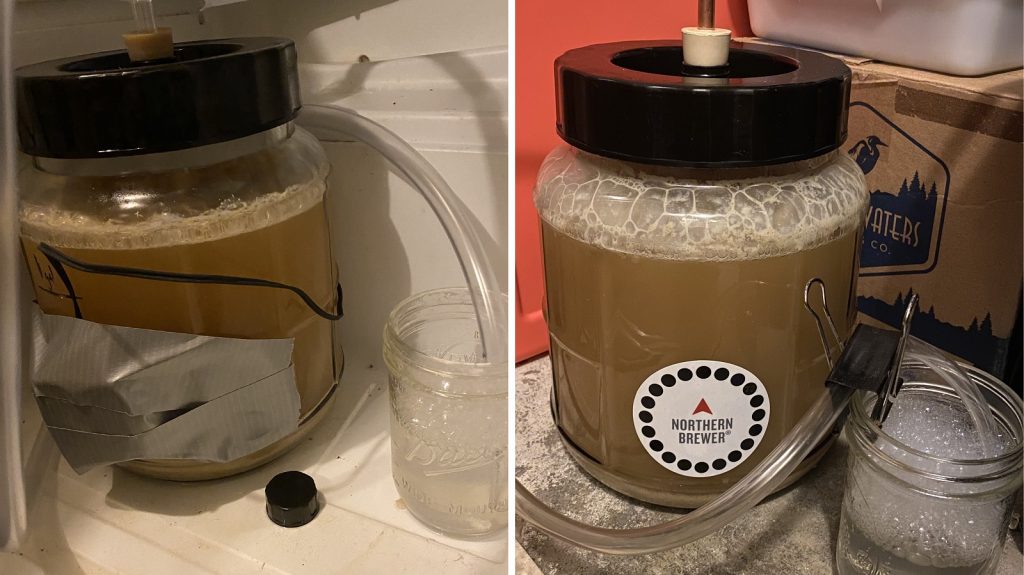












4 thoughts on “The Brü Club xBmt Series | Fermentation Temperature: Wyeast 3944 Belgian Witbier”
Nice write-up! Did you get much yeast character? I just had my first experience with this yeast when fermenting a wit at 68 F, but I got hardly any yeast character. The beer was a little too clean. I pitched from a starter grown from a fresh pack. Maybe too much yeast? Maybe too cold? Maybe a special mash rest is needed?
Thanks! I do get yeast character, but it was definitely on the cleaner/more subtle side. I haven’t tried other witbier yeast (like WLP400) to compare. Also the only times I’ve used this yeast, I added coriander and orange peel, which could potentially mask yeast character. You could try underpitching a bit and fermenting warmer, from what I’ve read those are both common techniques to increase yeast character in Saisons (someone more knowledgeable, please correct me if I’m wrong about that). As far as a special mash rest, I don’t know. The only reason I do the protein rest is because I found I get more consistent and increased efficiency when doing it with beers with a higher proportion of wheat (flaked or malted).
I too love Witbier and have never gradually adjusted the fermentation temperature. Guess now I never will! Thanks!
“You could try underpitching a bit and fermenting warmer”
Just a guess but this might be the thing to try if the experiment got a phase 2 — 2 batches with equal underpitches, one fermented at 75 and the other following the schedule first described of slowly ramping from 63 to 75.
One hitch I could see is that the batch that starts at 75 might finish even sooner than this one, and then you’d be testing an older beer against a younger one. I would bet the difference wouldn’t matter, but it might add another variable to hammer out.
Anyway, this is an interesting piece of the puzzle, thanks.